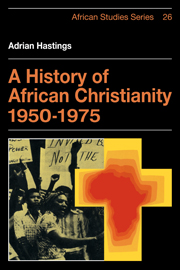Summary
Church and State
In 1950 Africa was predominantly a colonial, and even a quiet, continent. In Ethiopia the Emperor Haile Selassie I, King of Kings, Conquering Lion of Juda, Elect of God, ruled on the throne from which he had temporarily been driven by Mussolini. With the exception of five years of exile (1936–41) he had ruled Ethiopia since his appointment as regent in 1916. In 1930 he was crowned emperor. Already in 1950 a ruler with a long history and a considerable international reputation he had shouldered the task of combining the divine right of kings with the modernisation of his poor and inaccessible kingdom, particularly in the field of education. On his return to Addis Ababa in May 1941 he had declared his intention of ‘establishing in Ethiopia Christian ethics in government, liberty of conscience and democratic institutions’. For the next thirty years he would be engaged as he grew older with, perhaps, diminishing success in combining such ideals with the practice of a divine monarch, a narrow feudal aristocracy and a privileged state church which included scarcely half the inhabitants of the country. While the reality of his rule hardly measured up to that programme of 1941, the power of its symbolism throughout a colonial continent was immense.
Besides Ethiopia only Liberia, Egypt and South Africa were independent African states in 1950, and even there the independence was incomplete. In King Farouk's Egypt the Wafd swept into power with an overwhelming electoral victory in January of that year; its programme was to establish the political unity of the Nile Valley, of the Sudan with Egypt, under the Egyptian crown, and at the same time to bring about the withdrawal of the British army from the canal zone.
- Type
- Chapter
- Information
- A History of African Christianity 1950–1975 , pp. 5 - 85Publisher: Cambridge University PressPrint publication year: 1979

